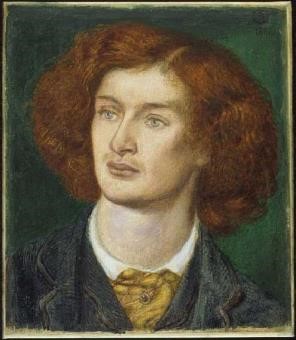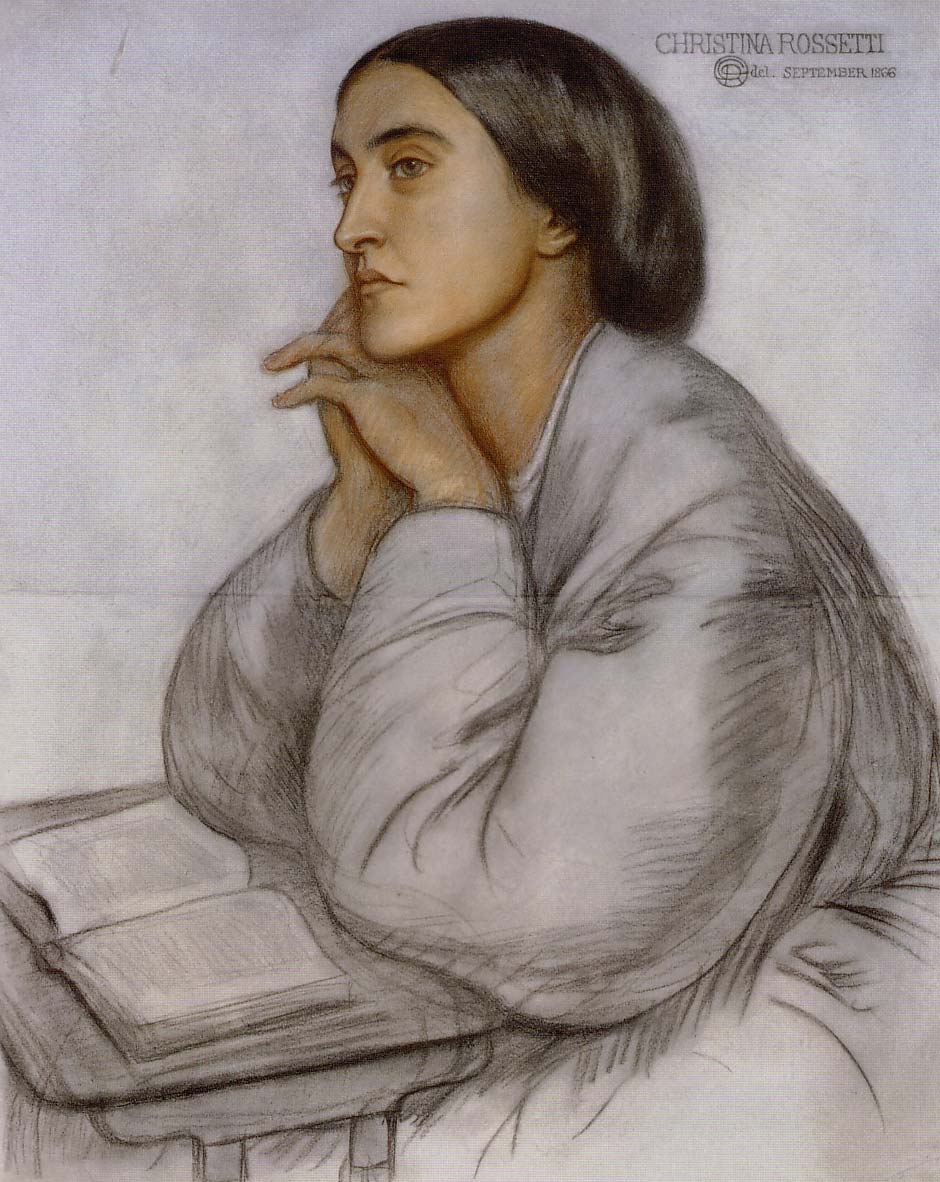|
Roundel (poetry)
A roundel (not to be confused with the rondel) is a form of verse used in English language poetry devised by Algernon Charles Swinburne (1837–1909). It is the Anglo-Norman form corresponding to the French '' rondeau''. It makes use of refrains, repeated according to a certain stylized pattern. A roundel consists of nine lines each having the same number of syllables, plus a refrain after the third line and after the last line. The refrain must be identical with the beginning of the first line: it may be a half-line, and rhymes with the second line. It has three stanzas and its rhyme scheme is as follows: A B A R ; B A B ; A B A R ; where R is the refrain. Swinburne had published a book ''A Century of Roundels''. He dedicated these poems to his friend Christina Rossetti, who then started writing roundels herself, as evidenced by the following examples from her anthology of poetry: ''Wife to Husband; A Better Resurrection; A Life's Parallels; Today for me; It is finished ... [...More Info...] [...Related Items...] OR: [Wikipedia] [Google] [Baidu] |
Rondel (poem)
A rondel is a verse form originating in French lyrical poetry of the 14th century. It was later used in the verse of other languages as well, such as English and Romanian. It is a variation of the rondeau consisting of two quatrains followed by a quintet (13 lines total) or a sestet (14 lines total). It is not to be confused with the roundel, a similar verse form with repeating refrain. The first two lines of the first stanza are refrains, repeating as the last two lines of the second stanza and the third stanza. (Alternately, only the first line is repeated at the end of the final stanza). For instance, if A and B are the refrains, a rondel will have a rhyme scheme of ABba abAB abbaA(B) The meter is open, but typically has eight syllables. There are several variations of the rondel, and some inconsistencies. For example, sometimes only the first line of the poem is repeated at the end, or the second refrain may return at the end of the last stanza. Henry Austin Dobson provide ... [...More Info...] [...Related Items...] OR: [Wikipedia] [Google] [Baidu] |
Poetry
Poetry (derived from the Greek ''poiesis'', "making"), also called verse, is a form of literature that uses aesthetic and often rhythmic qualities of language − such as phonaesthetics, sound symbolism, and metre − to evoke meanings in addition to, or in place of, a prosaic ostensible meaning. A poem is a literary composition, written by a poet, using this principle. Poetry has a long and varied history, evolving differentially across the globe. It dates back at least to prehistoric times with hunting poetry in Africa and to panegyric and elegiac court poetry of the empires of the Nile, Niger, and Volta River valleys. Some of the earliest written poetry in Africa occurs among the Pyramid Texts written during the 25th century BCE. The earliest surviving Western Asian epic poetry, the '' Epic of Gilgamesh'', was written in Sumerian. Early poems in the Eurasian continent evolved from folk songs such as the Chinese ''Shijing'', as well as religious hymns (the S ... [...More Info...] [...Related Items...] OR: [Wikipedia] [Google] [Baidu] |
Algernon Charles Swinburne
Algernon Charles Swinburne (5 April 1837 – 10 April 1909) was an English poet, playwright, novelist, and critic. He wrote several novels and collections of poetry such as '' Poems and Ballads'', and contributed to the famous Eleventh Edition of the ''Encyclopædia Britannica''. Swinburne wrote about many taboo topics, such as lesbianism, sado-masochism, and anti-theism. His poems have many common motifs, such as the ocean, time, and death. Several historical people are featured in his poems, such as Sappho ("Sapphics"), Anactoria ("Anactoria"), and Catullus ("To Catullus"). Biography Swinburne was born at 7 Chester Street, Grosvenor Place, London, on 5 April 1837. He was the eldest of six children born to Captain (later Admiral) Charles Henry Swinburne (1797–1877) and Lady Jane Henrietta, daughter of the 3rd Earl of Ashburnham, a wealthy Northumbrian family. He grew up at East Dene in Bonchurch on the Isle of Wight. The Swinburnes also had a London home at Whiteha ... [...More Info...] [...Related Items...] OR: [Wikipedia] [Google] [Baidu] |
Rondeau (poetry)
A ''rondeau'' (; plural: ''rondeaux'') is a form of medieval and Renaissance French poetry, as well as the corresponding musical chanson form. Together with the ballade and the virelai it was considered one of the three ''formes fixes'', and one of the verse forms in France most commonly set to music between the late 13th and the 15th centuries. It is structured around a fixed pattern of repetition of material involving a refrain. The rondeau is believed to have originated in dance songs involving alternating singing of the refrain elements by a group and of the other lines by a soloist. The term "Rondeau" is today used both in a wider sense, covering several older variants of the form – which are sometimes distinguished as the triolet and rondel – and in a narrower sense referring to a 15-line variant which developed from these forms in the 15th and 16th centuries. The rondeau is unrelated with the much later instrumental dance form that shares the same name in French baro ... [...More Info...] [...Related Items...] OR: [Wikipedia] [Google] [Baidu] |
Refrain
A refrain (from Vulgar Latin ''refringere'', "to repeat", and later from Old French ''refraindre'') is the line or lines that are repeated in music or in poetry — the "chorus" of a song. Poetic fixed forms that feature refrains include the villanelle, the virelay, and the sestina. In popular music, the refrain or chorus may contrast with the verse melodically, rhythmically, and harmonically; it may assume a higher level of dynamics and activity, often with added instrumentation. Chorus form, or strophic form, is a sectional and/or additive way of structuring a piece of music based on the repetition of one formal section or block played repeatedly. Usage in history In music, a refrain has two parts: the lyrics of the song, and the melody. Sometimes refrains vary their words slightly when repeated; recognizability is given to the refrain by the fact that it is always sung to the same tune, and the rhymes, if present, are preserved despite the variations of the words. Suc ... [...More Info...] [...Related Items...] OR: [Wikipedia] [Google] [Baidu] |
Christina Rossetti
Christina Georgina Rossetti (5 December 1830 – 29 December 1894) was an English writer of romantic, devotional and children's poems, including " Goblin Market" and "Remember". She also wrote the words of two Christmas carols well known in Britain: "In the Bleak Midwinter", later set by Gustav Holst, Katherine Kennicott Davis, and Harold Darke, and "Love Came Down at Christmas", also set by Darke and other composers. She was a sister of the artist and poet Dante Gabriel Rossetti and features in several of his paintings. Early life and education Christina Rossetti was born in Charlotte Street (now Hallam Street), London, to Gabriele Rossetti, a poet and a political exile from Vasto, Abruzzo, Italy, since 1824 and Frances Polidori, the sister of Lord Byron's friend and physician John William Polidori. She had two brothers and a sister: Dante Gabriel became an influential artist and poet, and William Michael and Maria both became writers. Christina, the youngest and a lively ... [...More Info...] [...Related Items...] OR: [Wikipedia] [Google] [Baidu] |
The Little Eyes That Never Knew Light
''The'' () is a grammatical article in English, denoting persons or things already mentioned, under discussion, implied or otherwise presumed familiar to listeners, readers, or speakers. It is the definite article in English. ''The'' is the most frequently used word in the English language; studies and analyses of texts have found it to account for seven percent of all printed English-language words. It is derived from gendered articles in Old English which combined in Middle English and now has a single form used with pronouns of any gender. The word can be used with both singular and plural nouns, and with a noun that starts with any letter. This is different from many other languages, which have different forms of the definite article for different genders or numbers. Pronunciation In most dialects, "the" is pronounced as (with the voiced dental fricative followed by a schwa) when followed by a consonant sound, and as (homophone of pronoun ''thee'') when followed by a ... [...More Info...] [...Related Items...] OR: [Wikipedia] [Google] [Baidu] |
Edward Elgar
Sir Edward William Elgar, 1st Baronet, (; 2 June 1857 – 23 February 1934) was an English composer, many of whose works have entered the British and international classical concert repertoire. Among his best-known compositions are orchestral works including the '' Enigma Variations'', the '' Pomp and Circumstance Marches'', concertos for violin and cello, and two symphonies. He also composed choral works, including ''The Dream of Gerontius'', chamber music and songs. He was appointed Master of the King's Musick in 1924. Although Elgar is often regarded as a typically English composer, most of his musical influences were not from England but from continental Europe. He felt himself to be an outsider, not only musically, but socially. In musical circles dominated by academics, he was a self-taught composer; in Protestant Britain, his Roman Catholicism was regarded with suspicion in some quarters; and in the class-conscious society of Victorian and Edwardian Britain, he was a ... [...More Info...] [...Related Items...] OR: [Wikipedia] [Google] [Baidu] |
Rondel (poem)
A rondel is a verse form originating in French lyrical poetry of the 14th century. It was later used in the verse of other languages as well, such as English and Romanian. It is a variation of the rondeau consisting of two quatrains followed by a quintet (13 lines total) or a sestet (14 lines total). It is not to be confused with the roundel, a similar verse form with repeating refrain. The first two lines of the first stanza are refrains, repeating as the last two lines of the second stanza and the third stanza. (Alternately, only the first line is repeated at the end of the final stanza). For instance, if A and B are the refrains, a rondel will have a rhyme scheme of ABba abAB abbaA(B) The meter is open, but typically has eight syllables. There are several variations of the rondel, and some inconsistencies. For example, sometimes only the first line of the poem is repeated at the end, or the second refrain may return at the end of the last stanza. Henry Austin Dobson provide ... [...More Info...] [...Related Items...] OR: [Wikipedia] [Google] [Baidu] |
.jpg)


.png)
